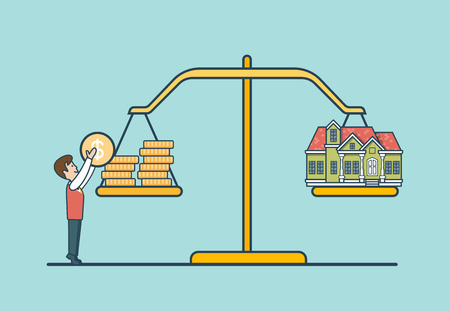1. Understanding What Makes a Property Undervalued
Finding undervalued properties is the key to making profitable real estate flips. But what exactly makes a property undervalued? Several factors can contribute to a propertys lower-than-market price, including market conditions, distress sales, and overlooked potential. Understanding these factors will help you identify great investment opportunities.
Market Conditions
Real estate markets fluctuate based on supply, demand, interest rates, and economic conditions. In certain market phases, properties may be undervalued due to external factors rather than their actual worth.
(1) Buyers Market vs. Sellers Market
| Market Type | Description | Impact on Property Values |
|---|---|---|
| Buyers Market | More homes for sale than buyers | Lower prices, more negotiation power |
| Sellers Market | More buyers than available homes | Higher prices, bidding wars |
(2) Economic Downturns
During economic downturns, homeowners may struggle to keep up with mortgage payments, leading to foreclosures and short sales. These situations often result in discounted property prices.
Distress Sales
A distressed property is one that is being sold under financial or personal hardship. These types of sales often present opportunities for investors looking for undervalued properties.
(1) Foreclosures
Banks sell foreclosed homes at a discount to recover their losses. While these properties may need repairs, they can be great investment opportunities.
(2) Short Sales
A short sale happens when a homeowner sells their property for less than the remaining mortgage balance with lender approval. These deals are typically below market value but require patience due to lender negotiations.
(3) Estate Sales
Properties sold as part of an estate settlement are often priced below market value for a quick sale. Heirs may not want to deal with maintaining or managing the property.
Overlooked Potential
Some properties are undervalued simply because buyers fail to recognize their potential. These hidden gems can provide excellent returns when properly renovated or repositioned.
(1) Cosmetic Fixer-Uppers
Homes that appear outdated or need minor cosmetic repairs may scare off traditional buyers but can be easily upgraded for a profit.
(2) Poor Marketing or Presentation
Poorly listed properties with bad photos, incomplete descriptions, or incorrect pricing often get overlooked by buyers. Investors who do their research can find great deals in these listings.
(3) Undeveloped or Underutilized Spaces
A property with extra land, unfinished basements, or unused attic space can have significant untapped value when properly developed.
Understanding these factors will help you spot undervalued properties before other investors do. By focusing on market conditions, distress sales, and hidden potential, you can find profitable opportunities for flipping houses.
2. Researching the Right Markets
Finding undervalued properties starts with choosing the right market. Not all neighborhoods or cities offer the same investment potential, so its crucial to analyze key factors like housing trends, job growth, and local demand before making a purchase.
Key Factors to Analyze
(1) Housing Trends
Look at historical price data and current market trends. Areas where home prices are rising steadily but still below their peak may indicate opportunities for profitable flips.
(2) Job Growth
Strong job markets attract more residents, increasing housing demand. Research cities with growing industries, new business developments, and low unemployment rates.
(3) Local Demand
Consider factors like population growth, rental demand, and buyer interest in specific neighborhoods. High demand often leads to faster sales and better returns.
Best Markets for Finding Undervalued Properties
| Market Factor | What to Look For | Why It Matters |
|---|---|---|
| Emerging Neighborhoods | Areas with new infrastructure, businesses, and improving amenities | Property values tend to rise as neighborhoods develop |
| High Foreclosure Rates | Cities with a large number of foreclosures or distressed properties | Often means lower property prices and greater investment potential |
| Low Property Taxes | States or counties with lower real estate taxes | Keeps holding costs down, increasing profitability on flips |
| Strong Rental Market | Cities with high rental occupancy rates and rising rents | Indicates strong housing demand, making resale easier |
| Population Growth | Regions experiencing steady or rapid population increases | A larger population creates higher housing demand and price appreciation potential |
How to Research Markets Effectively
(1) Use Online Real Estate Tools
Websites like Zillow, Redfin, and Realtor.com provide valuable insights into market trends, property values, and neighborhood conditions.
(2) Check Government Data Sources
The U.S. Census Bureau and Bureau of Labor Statistics offer data on population growth, employment trends, and economic health.
(3) Network with Local Agents & Investors
Real estate agents and local investors often have firsthand knowledge of emerging markets and undervalued properties.
(4) Visit the Area in Person
If possible, walk through potential neighborhoods to assess conditions firsthand. Look for signs of revitalization such as new businesses, renovated homes, or community investments.
Final Thoughts on Choosing the Right Market
Selecting the best market for undervalued properties requires thorough research. By analyzing housing trends, job growth, and local demand, you can identify areas with high flip potential. Keep an eye on developing neighborhoods and stay informed about economic shifts to maximize your investment success.

3. Finding Deals Through Off-Market Opportunities
One of the best ways to find undervalued properties for profitable flips is by exploring off-market opportunities. These deals are not listed on the Multiple Listing Service (MLS), meaning less competition and potentially better prices. Here are some effective strategies to uncover hidden gems.
Direct Mail Campaigns
Sending direct mail to property owners can be a highly effective way to find motivated sellers who might be willing to sell below market value. Focus on targeting homeowners in distress, absentee landlords, or those with long-term vacant properties.
Steps to Run a Successful Direct Mail Campaign
- Identify Your Target Market – Look for pre-foreclosures, tax-delinquent properties, or inherited homes.
- Create a Compelling Message – Clearly explain how you can help the homeowner and why selling quickly might benefit them.
- Use Handwritten or Personalized Letters – This increases the chances of getting a response compared to generic printed mail.
- Follow Up Consistently – Many deals come from follow-ups, so don’t hesitate to send multiple letters over time.
Networking with Wholesalers
Wholesalers specialize in finding distressed properties and securing them at a low price before assigning the contract to an investor. Building strong relationships with wholesalers can provide you access to off-market deals before they hit the broader market.
How to Connect with Wholesalers
- Attend Local Real Estate Meetups – Many wholesalers frequent investor meetings and networking events.
- Join Online Real Estate Groups – Platforms like Facebook, BiggerPockets, and LinkedIn have active wholesaler communities.
- Reach Out Directly – Contact wholesalers through their websites or social media profiles and express your interest in buying properties.
Working with Real Estate Agents
A skilled real estate agent with experience in investment properties can help you find off-market deals through their personal network. Many agents know about pocket listings—properties that are available for sale but not publicly advertised.
Questions to Ask When Choosing an Agent
| Question | Why It Matters |
|---|---|
| “Do you work with investors regularly?” | An agent familiar with investors will understand your need for undervalued properties. |
| “Can you provide access to pocket listings?” | Pocket listings allow you to find deals before they hit the MLS. |
| “Do you have connections with distressed property owners?” | A well-connected agent may know sellers eager for a quick transaction. |
The Power of Persistence
Succeeding in off-market deal sourcing requires patience and consistency. Whether youre sending direct mail, networking with wholesalers, or working with an agent, the key is to stay proactive and follow up regularly. The more effort you put into finding these hidden gems, the greater your chances of landing a profitable flip.
4. Evaluating Renovation Costs and Profit Potential
Once youve identified an undervalued property, the next crucial step is to evaluate renovation costs and determine its potential after-repair value (ARV). Accurately estimating these figures ensures you dont overextend your budget and helps you calculate a realistic profit margin.
How to Estimate Repair Costs
Understanding repair costs is essential for a successful flip. Here’s how you can estimate them effectively:
(1) Conduct a Thorough Property Inspection
Walk through the property and take note of visible damage, outdated features, or structural issues that need fixing. Consider hiring a professional inspector to uncover hidden problems like plumbing or electrical issues.
(2) Categorize Repairs by Priority
Repairs can be grouped into three main categories:
| Category | Description |
|---|---|
| Essential Repairs | Fixing major structural issues, roofing, plumbing, electrical systems, foundation cracks. |
| Cosmetic Upgrades | Updating kitchens, bathrooms, flooring, painting, landscaping. |
| Optional Enhancements | Additions like smart home features, luxury finishes, or extended patios that may increase appeal but arent necessary. |
(3) Get Contractor Estimates
If youre not experienced in estimating costs, reach out to contractors for quotes on repairs. Getting multiple estimates will help you understand the true cost of renovations.
Determining After-Repair Value (ARV)
The ARV represents the estimated market value of the property after all renovations are complete. Heres how to calculate it:
(1) Analyze Comparable Sales (Comps)
Research recently sold properties in the same neighborhood with similar size, condition, and features. These “comps” provide insight into what buyers are willing to pay.
(2) Use the ARV Formula
The basic formula for ARV is:
ARV = Average Comparable Sale Price per Square Foot × Property’s Square Footage
(3) Factor in Market Trends
If property values are rising in the area due to demand, your ARV could be higher than expected. Conversely, if prices are dropping, adjust your expectations accordingly.
The 70% Rule for Flipping Profitability
A common rule in real estate flipping is the 70% rule, which helps investors determine their maximum allowable offer (MAO).
The formula:
MAO = (ARV × 70%) – Estimated Repair Costs
This ensures that after renovation expenses and selling costs, theres still room for profit.
5. Negotiating and Closing the Deal
Once youve identified an undervalued property, the next step is to negotiate a great purchase price and smoothly navigate the closing process. Effective negotiation skills can make a significant difference in your profit margin, ensuring you secure the best deal possible.
How to Negotiate the Best Price
Successful negotiations require preparation and strategy. Here are key steps to help you get the best deal:
(1) Do Your Homework
Understand the propertys market value by analyzing recent sales of similar homes in the area. Use tools like MLS listings, Zillow, or Redfin to gather data.
(2) Identify Seller Motivations
Knowing why the seller wants to sell can give you leverage. Are they facing foreclosure? Relocating quickly? Understanding their urgency helps shape your offer.
(3) Make a Strong but Reasonable Offer
Start with an offer that leaves room for negotiation while remaining competitive. Avoid lowballing, as it may turn sellers away.
(4) Highlight Your Strengths as a Buyer
If youre offering cash or have financing pre-approved, emphasize this in negotiations to make your offer more appealing.
(5) Use Contingencies Wisely
Add contingencies that protect you (such as inspection clauses), but avoid excessive conditions that might make your offer less attractive.
Navigating the Closing Process
The closing phase involves multiple steps that must be handled efficiently to finalize your purchase.
| Step | Description |
|---|---|
| (1) Open Escrow | An escrow company holds funds and ensures all terms are met before closing. |
| (2) Conduct Inspections | A home inspection helps identify potential issues before finalizing the deal. |
| (3) Secure Financing | If using a loan, ensure your lender processes everything on time. |
| (4) Title Search & Insurance | A title company checks for liens or ownership disputes and provides insurance. |
| (5) Final Walkthrough | A last check before closing ensures everything is in agreed condition. |
| (6) Sign Documents & Close | You’ll sign legal paperwork and transfer ownership officially. |
Tips for a Smooth Closing
(1) Stay Organized
Keep track of deadlines, required documents, and lender communications to prevent delays.
(2) Communicate Effectively
Maintain open communication with your real estate agent, lender, and title company to ensure everything moves forward smoothly.
(3) Be Prepared for Unexpected Costs
Closing costs may include fees for escrow services, title insurance, and loan processing. Budget accordingly to avoid surprises.

